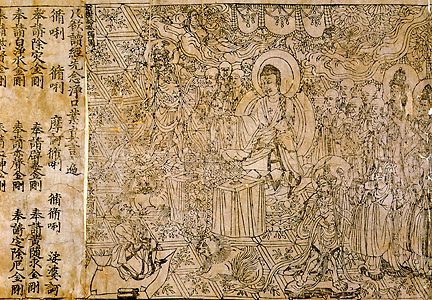Tang, << tahng, >> dynasty was a series of rulers who governed China from A.D. 618 to 907. Many historians consider the Tang period the golden age of Chinese civilization. The dynasty’s capital city, Chang’an (now Xi’an), became one of the great cultural centers of the world. Artists, poets, scholars, merchants, and government and religious leaders from many countries visited Chang’an and the Chinese coastal trading centers.

The Tang rulers united China and established a strong central government. They carefully hand-picked their chief officials. The Tang emperors also set up a council of ministers to act as advisers. In addition, the emperors sent inspectors into the provinces of China to check on the activities of local governors.
The Tang rulers also promoted trade, which became the basis of the empire’s great prosperity. Jade, porcelain, rice, silks, spices, tea, and other Chinese products flowed to India, the Middle East, and Europe along trade routes opened by the Tang emperors.
During the Tang period, the Chinese invented block printing, which soon replaced the handwritten scriptures of the Chinese Buddhists. In 868, the Chinese produced the Diamond Sutra, the world’s first block-printed book.

The rise of the dynasty.
The Tang dynasty followed the Sui dynasty, which had ruled China from A.D. 581 to 618. Li Yuan, an aristocrat, overthrew the Sui emperor and became the first Tang ruler (see Li Yuan). He set up his capital at Chang’an in northwestern China. Chang’an meant long peace, but China was soon torn by civil war. In addition, a struggle for power developed among the nobility. In 626, Li Yuan turned the control of China over to his son Li Shimin, who took the name Tang Taizong (also spelled T’ang T’ai-tsung). Taizong ruled for 23 years and became one of the greatest emperors in Chinese history.
Taizong was a powerful leader. He destroyed his competitors for the throne, began an alliance with the Korean state of Silla, and forced Turkish nomads out of Northern China. His armies conquered parts of Tibet and Turkestan, opening overland trade routes from China to India and central Asia. The trade routes not only brought great wealth to the empire, but they also promoted religious and cultural exchange. The routes gave Christian and other foreign missionaries an overland entrance into China and allowed Chinese Buddhist pilgrims to visit India.
Taizong reorganized the administration of the empire. He built colleges to help select and train officials for government work. Although Buddhism was the country’s main religion, Taizong knew that many Chinese who could help him carry out his programs followed Confucianism. As a result, he named many Confucians to high government posts.
In 649, Tang Gaozong (also spelled T’ang Gao-tsung) became emperor. But his wife, Empress Wu, soon took control of the government. Gaozong died in 683, and his son became emperor—but Empress Wu continued to control the government. She eventually proclaimed herself emperor, becoming the only woman in Chinese history to rule as emperor.
Empress Wu governed China with great skill. She appointed able ministers to major government posts and had the loyalty of her advisers and officials. Empress Wu maintained the high reputation of the Tang dynasty abroad because of her political brilliance. The empress also showed great favoritism to Buddhism and promoted art and literature. During the late 600’s, Tibet forced the Chinese out of Turkestan. To protect China’s trade routes there, Empress Wu sent her armies into the region and recovered the Tang territory.
The middle years.
Tang Xuanzong, the grandson of Empress Wu, became emperor in 712. Xuanzong, also known as Ming Huang (Brilliant Emperor), was the last of the three great Tang rulers. During his reign, China produced some of its best artists and such great poets as Li Bo (also spelled Li Po) and Du Fu (also spelled Tu Fu). Xuanzong’s economic programs, including the development of new farming regions in the Yangtze Valley, greatly increased China’s wealth.
In 747, China reached its peak of influence in western Asia. Tang armies invaded Bactria and Kashmir and defeated an Arab-Tibetan alliance that had been formed against China’s allies in central Asia. But in 751, a revolt in Turkestan closed China’s trade routes to the Middle East.
When Xuanzong was more than 60 years old, he fell in love with his son’s wife and took her as his mistress. She soon gained control over the emperor and made him appoint a cunning Turkish military governor, An Lushan, to the royal court. In 755, An Lushan organized a rebellion against Xuanzong and captured and briefly occupied the capital of Chang’an. In 756, Xuanzong turned the throne over to his son, Suzong. In 763, a combination of Chinese and foreign troops defeated the rebel armies of An Lushan. But during the rebellion, army generals and military governors in the provinces had increased their power, weakening the central government.
In addition, Tibet had been united into a powerful kingdom while Suzong was fighting An Lushan. In 763, Tibetan forces invaded China. Forces of the Tang rulers battled the Tibetans in northwestern China for about 80 years. This conflict further weakened the Tang dynasty.
The fall of the dynasty.
Border wars and rebellions in the provinces troubled China from 763 to 874. Yet the Tang dynasty remained prosperous, largely because of a new tax system. The Chinese had been required to pay their taxes with labor and goods. Under the new system, they could also pay with cash. This new system was more efficient than the older one and provided increased income.
In 874, Huang Chao led a peasant uprising, and in 881 the rebels captured the capital of Chang’an. They were defeated in 884, but afterwards the weakened central government could no longer control its generals or provincial governors.
In 907, the Tang dynasty finally came to an end. Until the Song dynasty gained control of China in 960, the country was governed by a series of short-lived military dynasties.
